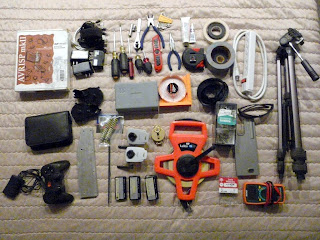Now that we are all back in Atlanta, and have had a little rest, I thought I would post a recap of the field trials. Since the sun comes up so early in Anchorage, we set out about 6:00am Wednesday morning and arrived at Byron Glacier trial by 7:30am. While Anchorage is completely devoid of snow, the trail head showed signs of several feet of snow still present. Cold weather gear and snow shoes were required to walk around. The glacier starts about a mile into the trial, which took 45 minutes or longer to walk, encumbered as we were with test equipment, supplies, and a robot.
Once we encountered a likely looking test site, we setup a simple base camp and started bringing the SnoMote online. The major goal of this expedition was to test the remote communication system between the rover and the external science server in Atlanta. Secondary goals included using the rover to perform a local elevation survey, and testing the accuracy of the mapping system. At the base camp location, we performed several variations of both these tests. After three hours of successful testing, we explored further up the glacier path. The melt water from the glacier formed a small stream, and we decided to perform a second round of tests in that area.
During previous seasons of testing, we chartered a helicopter to drop us off at the test site. This was the first over-land trail. Unfortunately, the stress of being transported long distances by hand, and not particularly gently either, led to a failure of one of the front steering linkages. Fortuitously, this actually occurred at the very end of the second round of testing, and did not impact any of the data collection goals. It does mean more work for Monday though, as I fix the broken ski and find a way to improve upon the current design for future missions.
I have posted another short slideshow of highlights from the Byron Glacier trials. You can see our intrepid band of scientists with all our equipment, as well as the SnoMote tackling some icy terrain. Check it out on the right-hand panel.
Sunday, May 9, 2010
Wednesday, May 5, 2010
Finished field testing
Posted on 4:19 PM in by Stephen Williams
We just completed our field tests and are heading back to the hotel.
The trials seem to have been a success; files were uploaded to the
server during the test. The files are being processed by the server,
and should start showing up shortly. I'll make a more in depth post
later, including a slideshow, but for now we are exhausted.
The trials seem to have been a success; files were uploaded to the
server during the test. The files are being processed by the server,
and should start showing up shortly. I'll make a more in depth post
later, including a slideshow, but for now we are exhausted.
Stephen Williams
The day is finally here
Posted on 7:00 AM in by Stephen Williams
> It's 5:30 in Anchorage, the sun has been up for awhile now, we have
> our gear and robot ready to go, and we are headed to Byron Glacier.
> I'll be making posts via cell phone for the day, so they will be
> short (and misspelled).
>
> Stephen Williams
> our gear and robot ready to go, and we are headed to Byron Glacier.
> I'll be making posts via cell phone for the day, so they will be
> short (and misspelled).
>
> Stephen Williams
Saturday, May 1, 2010
Packing Up
Posted on 6:15 PM in by Stephen Williams
 |  |
As you can see from the pictures, the time has come to pack up the SnoMote and all of our test equipment for transport to Alaska. The front suspension has been disassembled, which makes the SnoMote shorter for packing and shipping, as well as prevents damage to the skis and steering linkages. The SnoMote chassis is then wrapped and packed for the long plane ride.
 Next, we must deal with all of our test equipment. Despite the fact that the robot can drive by itself, we still need a vast array gear for our field tests. A large portion of this is for contingencies. Extra sensors, cameras, and computers are all included. If something were to break while on the glacier, we don't want to have to end the day's testing. Some care has been spent on the placement and accessibility of electronic components, and most can be replaced in the field.
Next, we must deal with all of our test equipment. Despite the fact that the robot can drive by itself, we still need a vast array gear for our field tests. A large portion of this is for contingencies. Extra sensors, cameras, and computers are all included. If something were to break while on the glacier, we don't want to have to end the day's testing. Some care has been spent on the placement and accessibility of electronic components, and most can be replaced in the field.In anticipation of this trip, I've been watching the weather in Anchorage. Either rain or snow was forecasted for basically every day in April. However, the first week of May is scheduled for some sunshine. So hopefully the weather will cooperate. As it stands, the highs should be in the 50's, with lows in the 30's. This is for downtown Anchorage however, and the temperatures around the glacier are significantly cooler. A talk with the park service indicated there was still plenty of snow on the ground, and that snow shoes will be required. They also informed me that this time of year was avalanche season. Field trials are always an adventure.
Subscribe to:
Posts (Atom)





